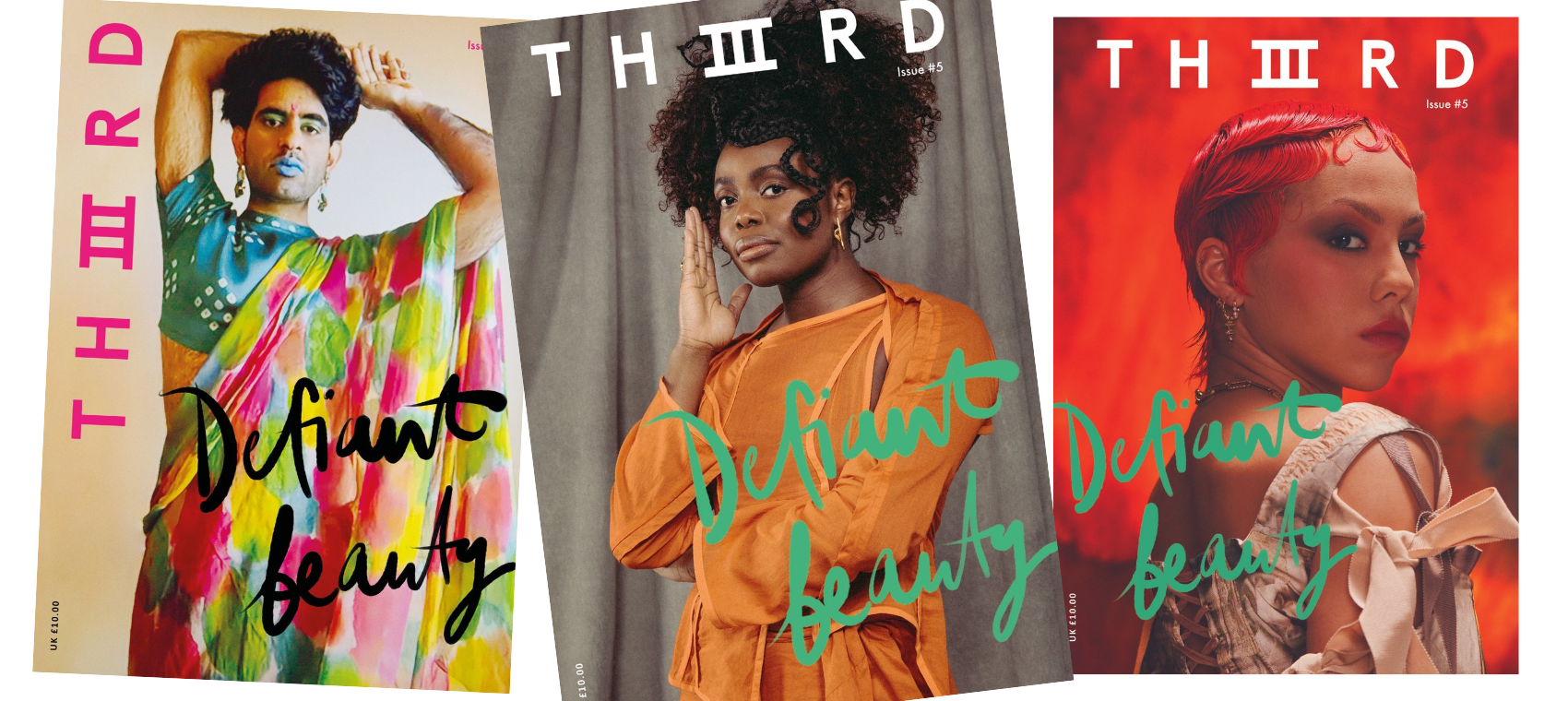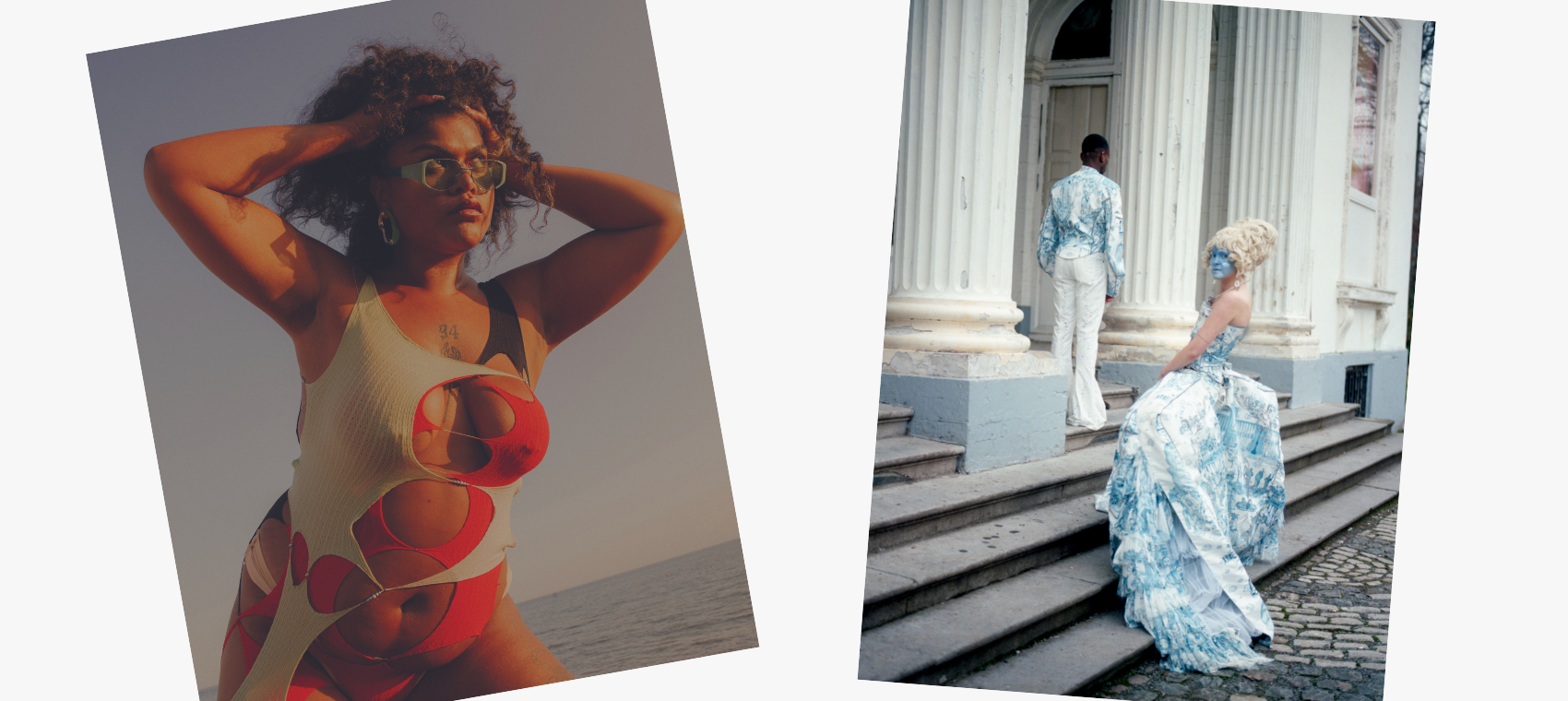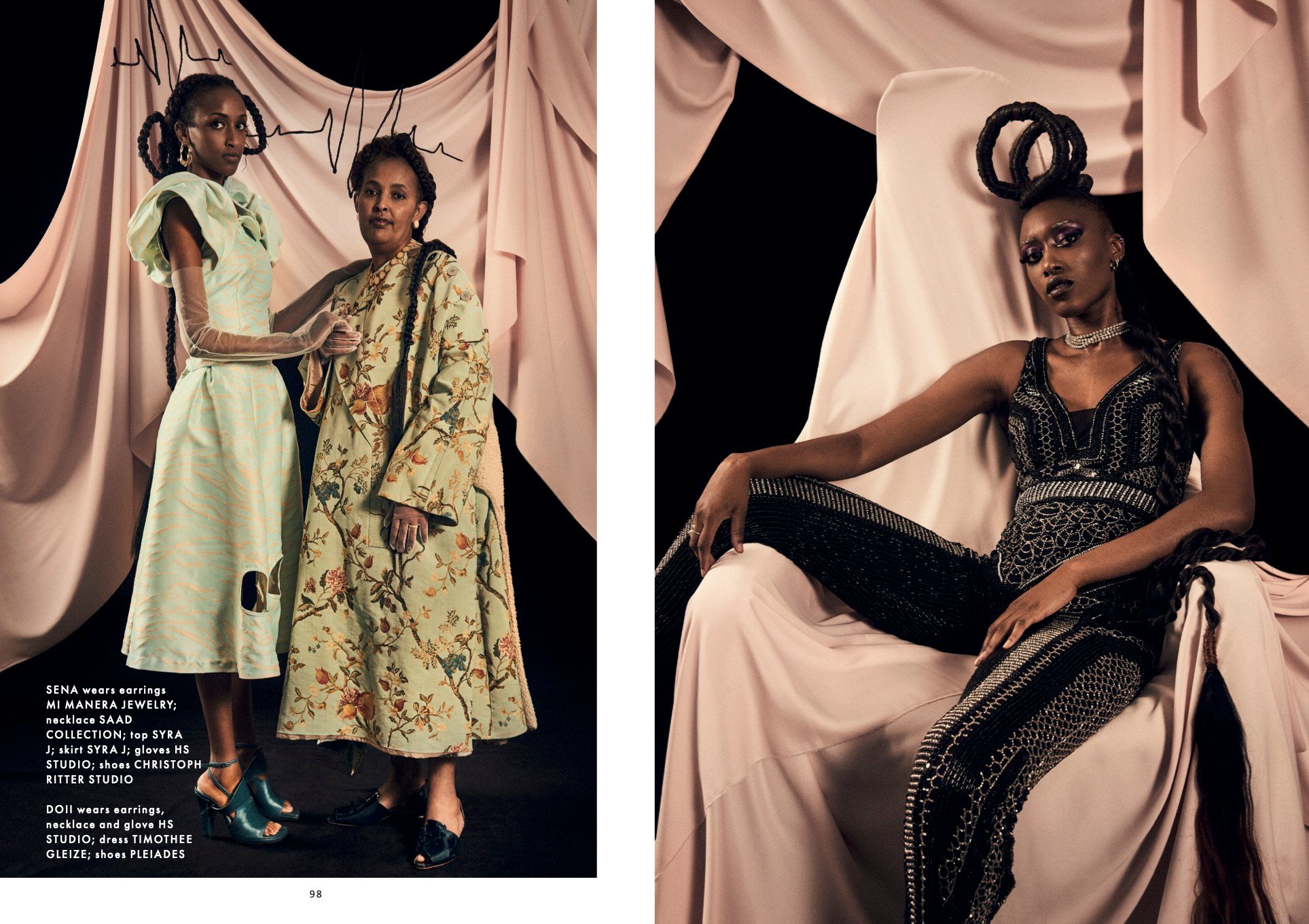![]() Rhona Ezuma
Rhona Ezuma
Rhona Ezuma is a stylist, writer and founder of THIIIRD - an independent magazine and inclusive platform amplifying underrepresented voices in print and online. Born and bred in London where she is based, her colourful work is plugged into popular culture, but informed by knowledge style codes of the eras, youth subcultures and black British culture. With a versatile book of clients, she regularly works between the realms of commercial campaigns, music, magazine and celebrity styling. Her editorial portfolio has featured in publications such as Vogue.it, GQ, Notion and Rollercoaster, whilst her commercial work has featured on billboards, TV screens and stages for the likes of Adidas, Sony Music Group and WGSN. She has worked in a number of countries, and is available to work, internationally.
“The ethos of THIIIRD is informed by decolonial and intersectional feminist thought. We believe in the potential of print and multimedia as a tool for (self-) affirmation and positive social change,” reads the publication’s manifesto.
To this end, the centrepiece of THIIIRD is its beautifully produced annual print magazine, now sold across three continents. In addition to this, THIIIRD has expanded its offering to include events and a podcast, as well as maintaining a discerning, informative and politically active social media presence which addresses such topics as myth-busting around Covid-19 vaccines to sharing petitions against punitive parliamentary bills.
Rhona Ezuma, who also recently spoke at magCulture Live in London, here tells us about THIIIRD’s origin story, how her work as a fashion stylist and creative director has informed her editorial approach, why diversity and inclusion needs be more than just making a few tweaks, what the future office might look like, and much more. Read the full Q&A below.

What’s your own professional / personal background, and how did that lead you to founding THIIIRD?
I’m a fashion stylist. One of the major drivers I had for becoming a stylist was the fascination I had with magazines and editorial. I loved that fashion editorials felt like a very open medium for storytelling, and how when I flicked through magazines you would see all these interesting, artistic people. However, when I entered the industry, I realised that in a lot of publications certain voices, bodies and stories didn’t get as much light, and that was simply because the industry wasn’t interested in celebrating them. Even though I chose a creative path, a lot of what I care about is informed by intersectional feminist and decolonial thinking, so coming to this realisation honed in to me that things needed to change. THIIIRD was born from that energy.
What’s the significance of the name THIIIRD?
A big part of what we aim to do with THIIIRD is celebrate diversity through centralising the representation of people who are typically marginalised. The three i’s in our name connect to three concepts that underlie how we approach that. One is the theory of third space, which is described as a hybrid place where colliding cultures and elements can blend and fuse to create something new and less hierarchical. Another is third culture, which is a merging of the first culture: so the backgrounds of your heritage of your parents, with the second culture: so the culture of the places you have lived in and grew up within.
And the final is the concept of the third eye understood as a place of deeper understanding and higher consciousness. Though we are an arts, fashion and culture magazine, we’ve always sought to situate our explorations of those things to society and self in ways that are in-depth, not reductive, or tokenising and remain embracing of intersectionality. Our name is a pledge to that.
I see myself more as the person responsible for our business development and the founder of a growing multi-media platform that wants to make an impact in wider culture and operate as a sustainable business.
You seem to juggle many roles – in your work as a fashion stylist, in radio, and as Editor-in-Chief of THIIIRD (and probably many more!). As the platform has grown, how has your own involvement changed?
I’ve always had a team who have helped me produce THIIIRD, so it’s always felt like something that is formed from group effort. From the beginning my role has been that of a leader of how the platform has taken shape and the direction of the overall vision but along the way, I am grateful to say we have team members who are probably way more on top of certain things we do than I am. That’s also allowed my role to evolve and the vision for the platform too. When we started it, it was very much a passion project that came to life because of the sheer belief that it needed to be made. Now as we are growing, I see myself more as the person responsible for our business development and the founder of a growing multi-media platform that wants to make an impact in wider culture and operate as a sustainable business.
Who makes up THIIIRD’s audience at the moment?
What we care about is very people of colour centred, very women-led and queer, so naturally, we find people who identify in these ways are a huge part or our audience. So that’s one way of looking at it, but another is anyone who loves music, art, fashion and photography, and cares about making society better for those communities. I think in truth anyone who wants to stay culturally and socially engaged, who gets that culture is a place for meditating and reflecting on the world around us, and who is not afraid of learning/unlearning is within our audience.
There’s a lot of talk in the media industry about the importance of having multiple revenue streams, so as to be more resilient to changes beyond our control (the whims of Big Tech, the decline of advertising, pandemics, etc.). What’s your approach?
I think that’s a fair approach. We do and have done that, but mostly diversification has stemmed from the possibility different mediums have offered us to do what we already do in new ways we are excited about. Often those opportunities come after a lot of hard work, re-skilling, planning etc. We are not a big publication or corporation that has a lot of cash to divert into lots of places, everything takes time, effort and learning; so diversification isn’t easy or simply commercially tactical for us. We have to believe there is something unique to gain there, that makes sense to us and what we do, in order to bother.
Our issue is where it all started for us, so the launch of a new one always feels like a massive celebratory moment.
We love to share success stories of print magazines. Can you tell us about THIIIRD’s annual print publication, now in its fifth edition?
Our issue is where it all started for us, so the launch of a new one always feels like a massive celebratory moment. Every issue has a central theme and what we tend to do with that theme is hack into it from diverse angles. We launched the fifth issue, Defiant Beauty, this year and we did it via a pre-order campaign that helped us go to print. The idea for that issue was to explore beauty by challenging the idea of a standard, or binary, Eurocentric ideals; and to celebrate beauty as something altruistic, active as averse to passive – defiant. It’s been amazing just how many voices we were able to bring together for the issues. We had 19 feature stars including Kelechi Okafor, Poppy Ajudha and Alok V Menon who are all wonderful individuals doing great work to bring activism closer to heart of creative creation.
What is the significance of THIIIRD podcasts and live events – where do they fit into your overall vision for the platform?
They continue the work we do but provide a different experience. For one, you see and hear more from the team, so on the podcast for example you hear Daniela, Tryb and myself. It’s very much the same THIIIRD lens applied to what we talk about and the guests we get to join us on the show, but the podcast allows us to talk about a whole range of different topics connected to pop, social and political culture, and episodes have ranged from discussing cultural appropriation and ethical tourism, to sober curiosity and polyamourus relationships. Similarly with our events, whether their panel talks or workshops, quite serious or a lot of fun, the experience is very intimate and we want to provide something to our community that they can take a part in and benefit from.
Listen to the THIIIRD WAVES podcast!
Were your events affected by the pandemic, and if so, how did you adapt?
Yes, we didn’t really have events in the way we typically do. A lot more effort went into how we could do things online on our social spaces. Any private events were on video conferencing.
What do you think a lot of publishers miss (or misunderstand) when it comes to diversity and inclusion?
I don’t know if I would direct this only to publishers but inclusion isn’t about adding new faces to the same system. It’s often about finding new ways to do things. Tokenism isn’t either one of those things. Diversity is often talked about like the antithesis of commerciality, and you have this idea that diversity doesn’t sell, or it can’t be marketed as niche, or it’s too hard to find. If you’re struggling to make diversity a part of the fabric of what you do, understand it’s not something you can pick up and drop, it needs investment, and also look around the room.

There is a huge public appetite for more diverse content, but new or smaller publications can come up against barriers such as funding and distribution. Did that affect THIIIRD at all?
Yep, we are independent, so we have faced those same hurdles. It’s something we are always working against and it’s why everyone who supports what we do by buying an issue, attending an event, buying merch is doing more than just purchasing a product of ours – they’re supporting what we do and stand for. As I mentioned as well, pre-orders took us to print this year so it really can’t be underestimated too.
Everyone who supports what we do by buying an issue, attending an event, buying merch is doing more than just purchasing a product of ours – they’re supporting what we do and stand for.
THIIIRD is sold in Europe, Asia, and the US – what challenges (if any) have you faced in expanding THIIIRD into these different markets? Do you plan to expand further in the future?
In many ways THIIIRD is a product of a multicultural city like London where you have many people from cultural diasporas present. The vision for expansion is based on bringing availability to more places like that. Obviously, shipping is really expensive, and all these new border laws are only adding to that, but luckily we work with an amazing distributor Ra & Olly which gets the vision for THIIIRD and helps us with that.

What other publications do you admire / draw inspiration from?
Getting into the industry it was always the edgy artsy ones. The magazine i-D was a personal favourite of mine for its straight ups and features that made a stand. Now it’s publications like gal-dem whose mission I believe in and journey I find very inspiring, and then publications I consider peers: Grrls Zine, Postscript, Black Ballad, Azeema, Paperboy – there’s always something special in their pages.
The way we work is undergoing a huge shift due to Covid-19. Do you have a view on “the office” and how to build a more inclusive workplace? How does the THIIIRD teamwork?
Zoom has been a goal changer. A lot of the THIIIRD team balance what we do with the magazine with other roles and responsibilities, so the ease of being able to take a meeting from home is one we won’t be forgetting any time soon. How to build an inclusive team is something that I think is best assessed business by business, and it’s a huge aspect of overall company culture, but for us it begins with creating an understanding that everyone in the ‘room’ has an impact and the ‘room’ wants to hear all voices in it.
Writer: Pierre De Villiers
This article is part of the #ModernPrint series, a content collaboration with FIPP, showcasing the role of print in the modern media mix.